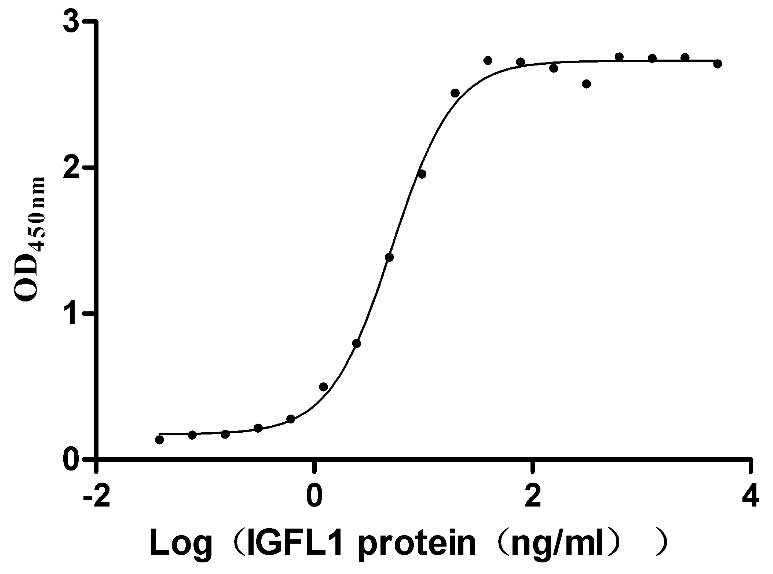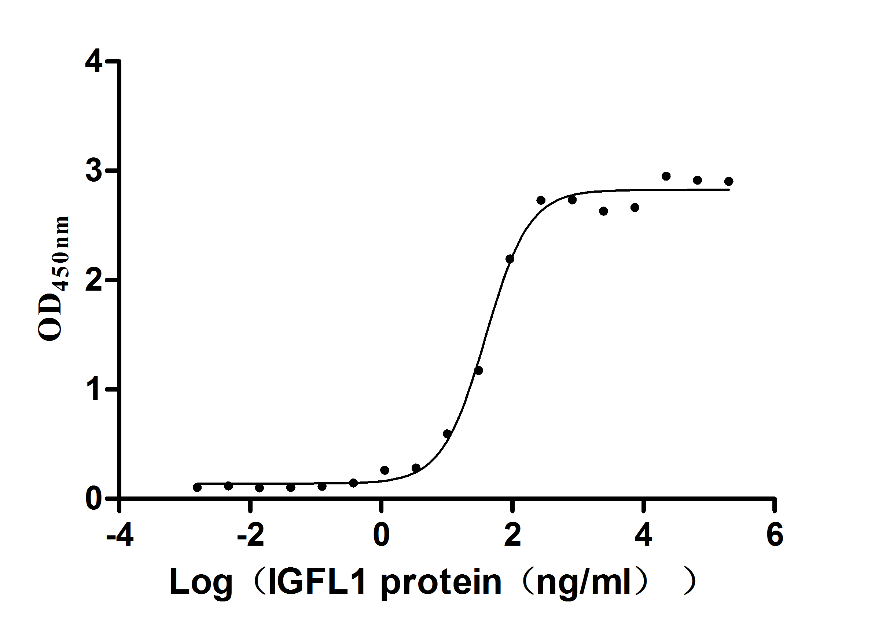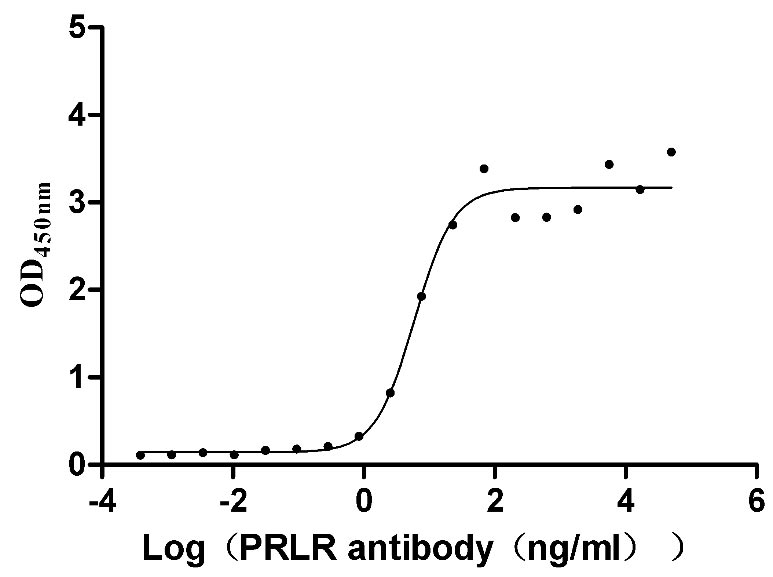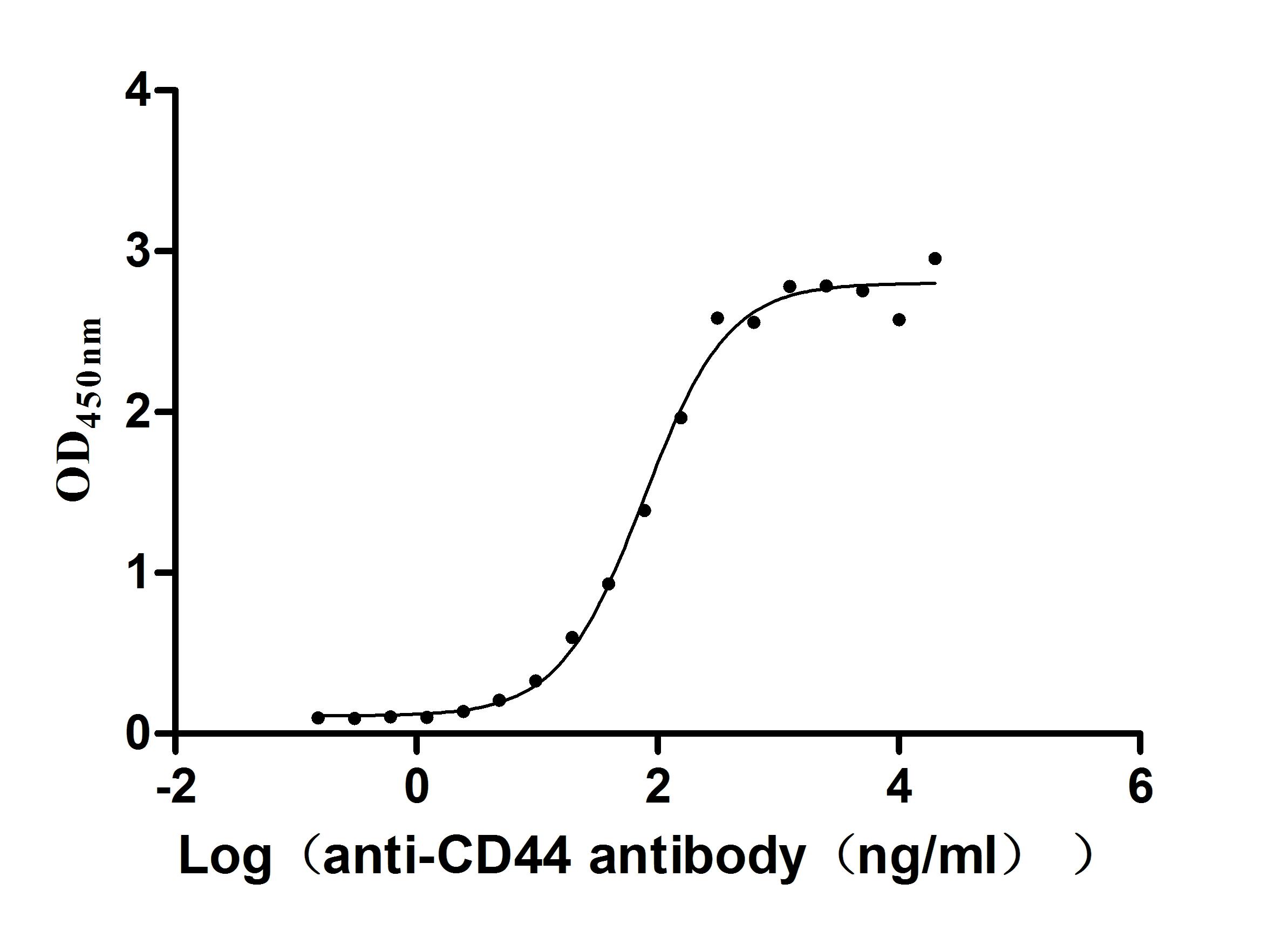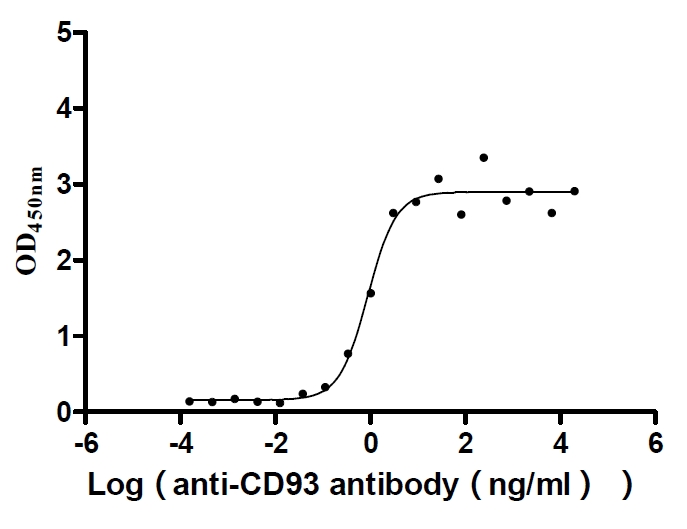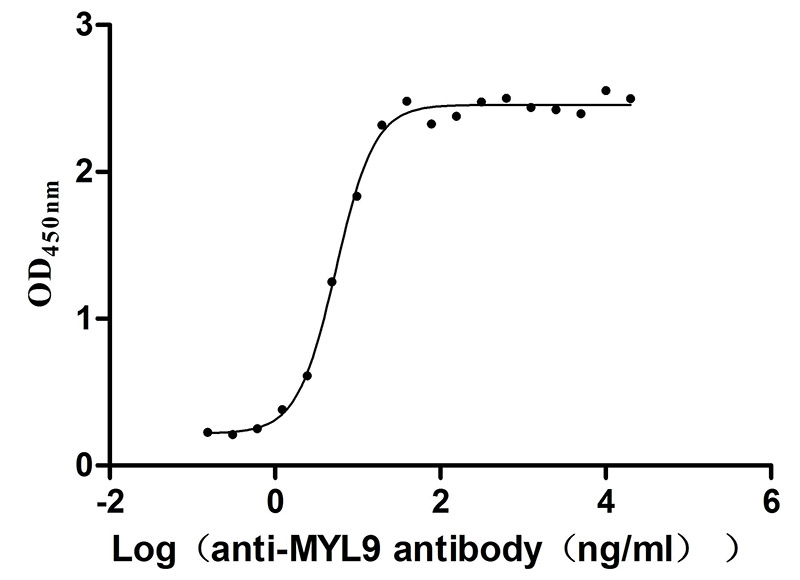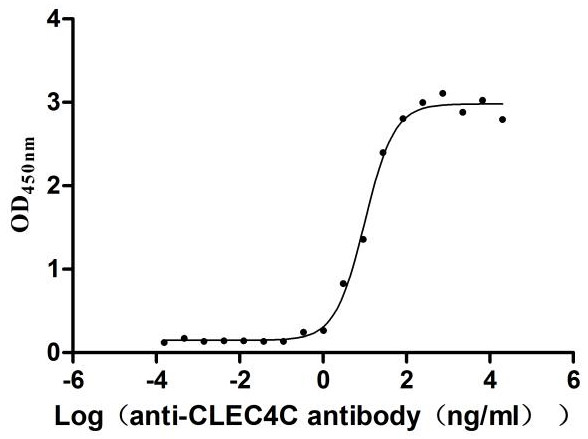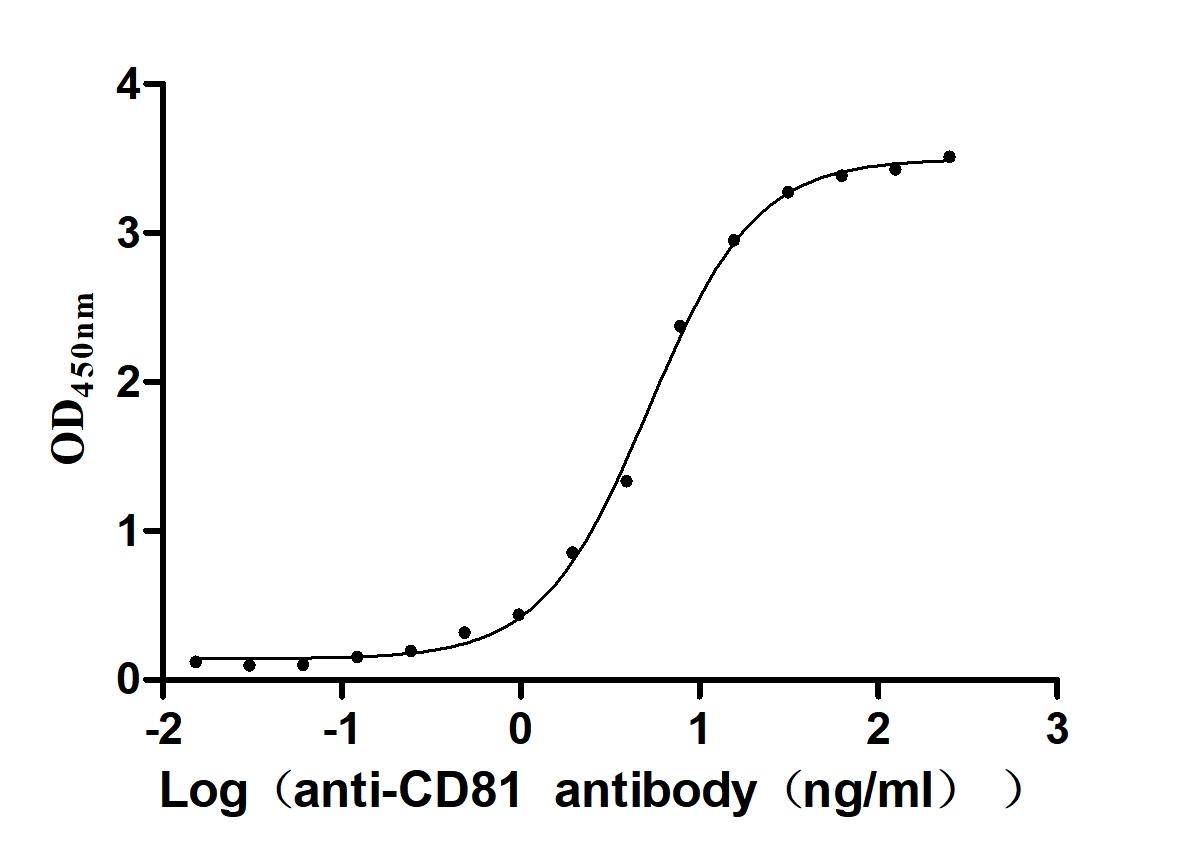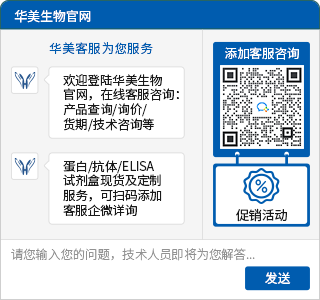Recombinant Human Hyaluronan-binding protein 2 (HABP2), partial
In Stock-
货号:CSB-EP617919HU(A4)
-
规格:¥1344
-
图片:
-
其他:
产品详情
-
纯度:Greater than 90% as determined by SDS-PAGE.
-
基因名:HABP2
-
Uniprot No.:
-
别名:Factor seven activating protease; Factor seven-activating protease; Factor VII activating protein; Factor VII-activating protease; FSAP; HABP 2; HABP; Habp2; HABP2_HUMAN; Hepatocyte growth factor activator like protein; Hepatocyte growth factor activator-like protein; HGFAL; Hyaluronan binding protein 2; Hyaluronan-binding protein 2 27 kDa light chain alternate form; Hyaluronic acid binding protein 2; PHBP; Plasma hyaluronan binding protein; Plasma hyaluronan-binding protein
-
种属:Homo sapiens (Human)
-
蛋白长度:Partial
-
来源:E.coli
-
分子量:43.3kDa
-
表达区域:314-560aa
-
氨基酸序列IYGGFKSTAGKHPWQASLQSSLPLTISMPQGHFCGGALIHPCWVLTAAHCTDIKTRHLKVVLGDQDLKKEEFHEQSFRVEKIFKYSHYNERDEIPHNDIALLKLKPVDGHCALESKYVKTVCLPDGSFPSGSECHISGWGVTETGKGSRQLLDAKVKLIANTLCNSRQLYDHMIDDSMICAGNLQKPGQDTCQGDSGGPLTCEKDGTYYVYGIVSWGLECGKRPGVYTQVTKFLNWIKATIKSESGF
Note: The complete sequence including tag sequence, target protein sequence and linker sequence could be provided upon request. -
蛋白标签:N-terminal 6xHis-SUMO-tagged
-
产品提供形式:Liquid or Lyophilized powder
Note: We will preferentially ship the format that we have in stock, however, if you have any special requirement for the format, please remark your requirement when placing the order, we will prepare according to your demand. -
缓冲液:Tris-based buffer,50% glycerol
-
储存条件:Store at -20°C/-80°C upon receipt, aliquoting is necessary for mutiple use. Avoid repeated freeze-thaw cycles.
-
保质期:The shelf life is related to many factors, storage state, buffer ingredients, storage temperature and the stability of the protein itself.
Generally, the shelf life of liquid form is 6 months at -20°C/-80°C. The shelf life of lyophilized form is 12 months at -20°C/-80°C. -
货期:3-7 business days
-
注意事项:Repeated freezing and thawing is not recommended. Store working aliquots at 4°C for up to one week.
-
Datasheet & COA:Please contact us to get it.
相关产品
靶点详情
-
功能:Cleaves the alpha-chain at multiple sites and the beta-chain between 'Lys-53' and 'Lys-54' but not the gamma-chain of fibrinogen and therefore does not initiate the formation of the fibrin clot and does not cause the fibrinolysis directly. It does not cleave (activate) prothrombin and plasminogen but converts the inactive single chain urinary plasminogen activator (pro-urokinase) to the active two chain form. Activates coagulation factor VII. May function as a tumor suppressor negatively regulating cell proliferation and cell migration.
-
基因功能参考文献:
- The presence of the noninheritable V600E BRAF mutation in this family supports Knudson's "double-hit" hypothesis for cancer development and suggests the involvement of more than 1 gene in the clinical expression of familial nonmedullary thyroid carcinoma. PMID: 29895015
- The MI-SNP and MII-SNP FSAP gene polymorphisms were not predictive or prognostic biomarkers for coronary artery diseaseor its main risk factors. PMID: 29927903
- NETs bind to FSAP, but do not activate pro-FSAP unless histones are released from NETs by DNAse. This activation of FSAP is likely to be important in diminishing the cytotoxic effect of histones, thus limiting the damaging effect of NETosis. PMID: 29178989
- Regulation of gene expression by FSAP in vascular smooth muscle/endothelial cells accounts for its vasculo-regulatory properties. PMID: 28881271
- The extent of CAC in women is positively associated with total FSAP, but negatively associated with the specific activity of FSAP suggesting that FSAP may play a role in the evolution of CVD in women. PMID: 28548975
- Report peptide substrates used in determining substrate specificity of Factor VII activating protease. PMID: 28726978
- Two of 20 probands from families with history of PTC and breast carcinoma (BC) were evaluated by whole exome sequencing (WES) revealing HABP2 p.G534E. PMID: 28402931
- No significant association was found between rs11196288 and early-onset ischemic stroke, large artery atherosclerotic stroke, or small vessel disease stroke. rs11196288 presented significant effect on late-onset SVD stroke susceptibility in the older population. PMID: 28501930
- study on a wide series of familial non-medullary thyroid cancers indicates that the HABP2(G534E) variant is frequent, but does not segregate with the disease PMID: 28222214
- Letter: G534E variant in HABP2 is not associated with non-medullary thyroid cancer in the Spanish population. PMID: 27245704
- mutations were not found in familial non-medullary thyroid cancer, and the G534E variant is not the underlying genetic defect in a large sample of sporadic non-medullary thyroid cancer from the Middle East. PMID: 26906432
- Study showed that lower FSAP antigen plasma levels were associated with a higher chance of arterial recanalization after tissue plasminogen activator treatment, suggesting an involvement of FSAP in tissue plasminogen activator-induced clot lysis. FSAP antigen determination might be useful in predicting tissue plasminogen activator response in stroke patients. PMID: 27073188
- HABP2 polymorphisms are not associated with thyroid cancer. PMID: 27873212
- the promoter activity, which could phenocopy changes in Habp2 mRNA in response to TGF-beta, was found to be located in the 177-bp region upstream of the transcription start site, and this region did not contain any SMAD binding sites. PMID: 27462075
- Results show that G534E germline variant in HABP2 does not account for the familial nature of nonmedullary thyroid cancer in Australian kindreds but and is common in the general population. PMID: 27530615
- omology modeling suggested that the Glu-221 side chain could sterically hinder insertion of the N terminus into the HABP2 protease domain, helping to explain the detrimental effects of Glu-221 substitution on HABP2 activity. PMID: 28246168
- The data do not support the pathogenicity of the HABP2 c.1601G > A variant but highlight the existence of a new one that should be more extensively searched for in familial papillary thyroid carcinoma patients and its pathogenicity more carefully evaluated. PMID: 28089742
- No evidence supporting a role for the HABP2 G534E variant (SNP rs7080536) in papillary thyroid carcinoma. PMID: 26745718
- HABP2 G534E appears to be a susceptibility gene in a subgroup of Familial Non-Medullary Thyroid Cancer (FNMTC), providing important diagnostic implications for this hereditary thyroid cancer. PMID: 26832773
- HABP2, which encodes an extracellular serine protease involved in coagulation, fibrinolysis, and inflammatory pathways, may be a genetic susceptibility locus for early-onset stroke. [Meta-Analysis] PMID: 26732560
- Patients with Gram-negative sepsis caused by B. pseudomallei have abundant FSAP activation, which significantly correlates with stage of disease. PMID: 25370187
- results suggest that the HABP2 G534E variant is a susceptibility gene for familial nonmedullary thyroid cancer PMID: 26222560
- CD44 expression in squamous cell carcinoma of the penis cannot predict the need of performing inguinal lymphadenectomy. PMID: 25847894
- FSAP functions in initiation and progression of hepatic fibrosis PMID: 24497464
- The possible effects of omega-3 FA on clinical AF potential could be linked with modulation of circulating FSAP levels. PMID: 23575879
- FSAP activates the NF-kappaB pathway and the associated downstream pro-inflammatory factors in monocytic cells PMID: 24075769
- The study demonstrated that a single nucleotide polymorphism (Marburg I) in the FSAP gene (HABP-2)results in a weak proteolytic activity against all substrates including FVII. PMID: 22906531
- Lower FSAP expression is associated with enhanced liver fibrosis and inflammation in patients with chronic hepatic disorders and murine experimental liver injury. PMID: 22989567
- Data indicate that FSAP mediates proteolytic cleavage and activation of bone morphogenetic protein-2 (BMP-2). PMID: 23341458
- High levels of FSAP activity were predictive of adverse events during follow-up, suggesting its potential role in risk stratification and clinical management of CAD patients. PMID: 22850287
- We conclude that FSAP Marburg-I genotyping may be used to determine the risk for thromboembolic disorders in patients with suspected thrombophilia and known DVT or PE. PMID: 22421107
- Report tissue factor pathway inhibitor as an efficient inhibitor of factor VII-activating protease. PMID: 22449009
- Increased plasma FSAP antigen levels and activity were associated with ischemic stroke and all main etiologic subtypes. PMID: 22409238
- These results indicate that polymorphisms in the regulatory region of HABP2 gene could influence gene expression levels in the receptive endometrium and be one reason for infertility complications in women with unexplained infertility. PMID: 21098215
- Data suggest that plasma FSAP activity levels were higher in women with recurrent pregnancy loss than in fertile women. PMID: 22383781
- A high correlation between FSAP activity and C5a was found in multiple trauma patients PMID: 22308306
- Factor VII-activating protease promotes the proteolysis and inhibition of tissue factor pathway inhibitor. PMID: 22116096
- SNP analyses indicate an important role for FSAP in the regulation of the haemostasis system as well as fibroproliferative inflammatory processes. [review] PMID: 21655671
- these results suggest pathophysiological relevance of histone-dependent pro-PHBP activation in hyperinflammatory process. PMID: 21600885
- Marburg I polymorphism of FSAP might not be associated with cerebral infarction. PMID: 20045910
- identified laccaic acid as a potent inhibitor of the protease in terms of both autoactivation of the PHBP proenzyme (IC(50) = 0.35-0.55 microg/ml) and the catalytic activity of the active enzyme (IC(50) = 1.1 microg/ml). PMID: 21071862
- FSAP inhibited platelet-derived growth factor-stimulated proliferation, migration, p42/p44 MAPK phosphorylation and collagen III synthesis of the human pulmonary fibroblasts. PMID: 20818495
- The protein products HABP2 and HYAL1 were associated with plasma PAI-1 concentration and play key roles in hyaluronan metabolism, providing genetic evidence to link these pathways. PMID: 20558613
- Report that polyamine induces the formation of pro-PHBP autoactivation complex, in which an intermolecular interaction between N-terminal region and the third EGF-like domain (E3) plays a role. PMID: 19817990
- Hyaluronic acid binding protein 2 (HABP2) negatively regulates vascular integrity via activation of protease-activated receptor/RhoA/Rho kinase signaling. It represents a potential therapeutic target for syndromes of increased vascular permeability. PMID: 20042707
- The frequency of factor VII-activating protease Marburg I is significantly increased in patients with a history of venous thromboembolism (VTE) or idiopathic VTE compared to healthy controls. PMID: 15486068
- An interactive effect upon risk was found between the 511E allele and elevated levels of cholesterol and triglyceride or fibrinogen. The findings support the proposal that the FSAP 511E allele exacerbates atherosclerosis or its clinical sequelae PMID: 15543324
- extracellular RNA, present at sites of cell damage or vascular injury, can serve an important as yet unrecognized cofactor function in haemostasis by inducing (auto-)activation of FSAP through a novel surface-dependent mechanism PMID: 15654766
- Marburg I polymorphism of factor VII-activating protease does not have a role in venous thrombosis [letter] PMID: 15933067
- exhibits a significant growth factor-like activity on quiescent human lung and dermal fibroblasts PMID: 16153533
显示更多
收起更多
-
相关疾病:Thyroid cancer, non-medullary, 5 (NMTC5)
-
亚细胞定位:Secreted. Note=Secreted as an inactive single-chain precursor and is then activated to a heterodimeric form.
-
蛋白家族:Peptidase S1 family
-
组织特异性:Ubiquitously expressed.
-
数据库链接:
HGNC: 4798
OMIM: 603924
KEGG: hsa:3026
STRING: 9606.ENSP00000277903
UniGene: Hs.422542
Most popular with customers
-
Recombinant Human IGF-like family receptor 1 (IGFLR1), partial (Active)
Express system: Mammalian cell
Species: Homo sapiens (Human)
-
Recombinant Human IGF-like family receptor 1 (IGFLR1), partial (Active)
Express system: Mammalian cell
Species: Homo sapiens (Human)
-
Recombinant Mouse Prolactin receptor (Prlr), partial (Active)
Express system: Mammalian cell
Species: Mus musculus (Mouse)
-
Recombinant Macaca fascicularis CD44 antigen (CD44), partial (Active)
Express system: Mammalian cell
Species: Macaca fascicularis (Crab-eating macaque) (Cynomolgus monkey)
-
Recombinant Human Complement component C1q receptor (CD93), partial (Active)
Express system: Mammalian cell
Species: Homo sapiens (Human)
-
Recombinant Human Myosin regulatory light polypeptide 9 (MYL9) (Active)
Express system: Yeast
Species: Homo sapiens (Human)
-
Recombinant Human C-type lectin domain family 4 member C (CLEC4C), partial (Active)
Express system: Mammalian cell
Species: Homo sapiens (Human)
-
Recombinant Human CD81 antigen (CD81), partial (Active)
Express system: Mammalian cell
Species: Homo sapiens (Human)

-SDS.jpg)

